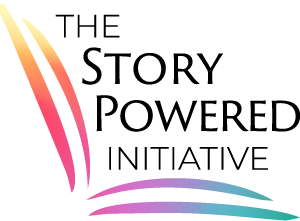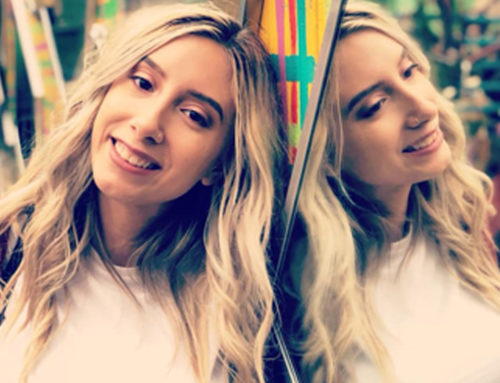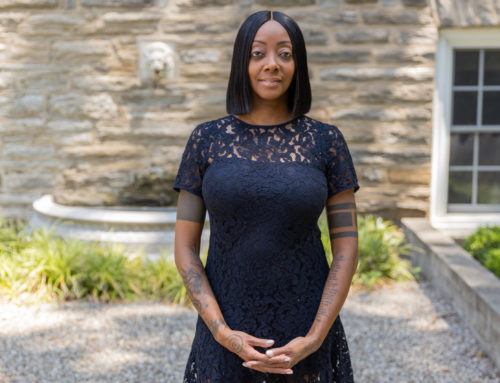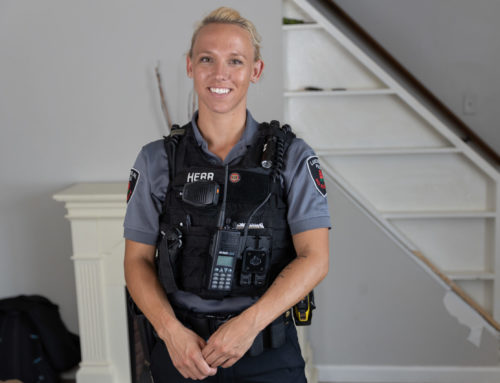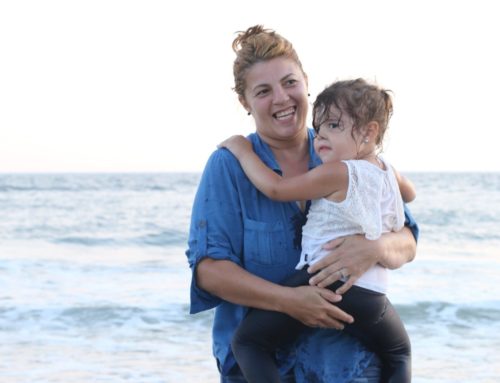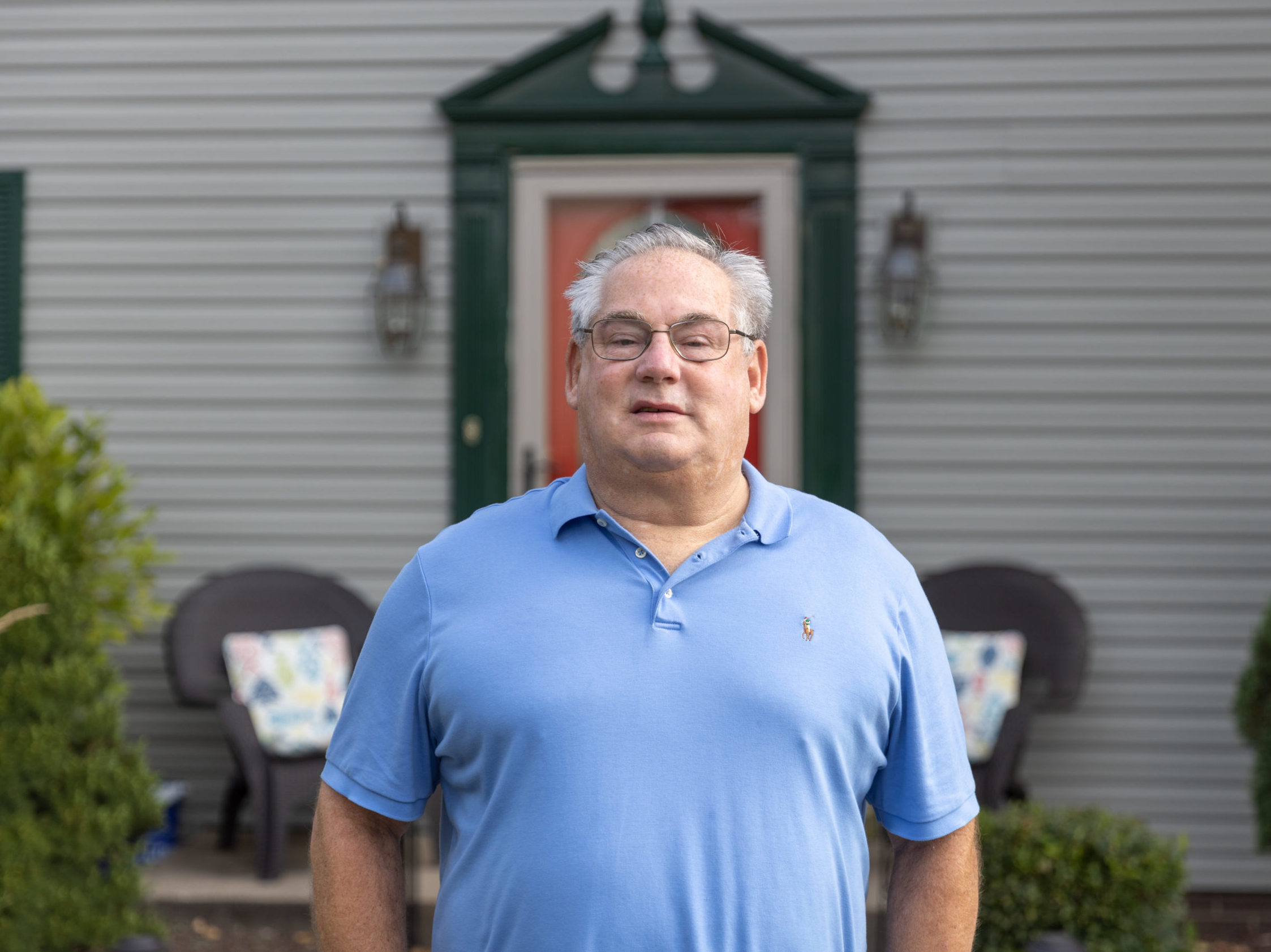
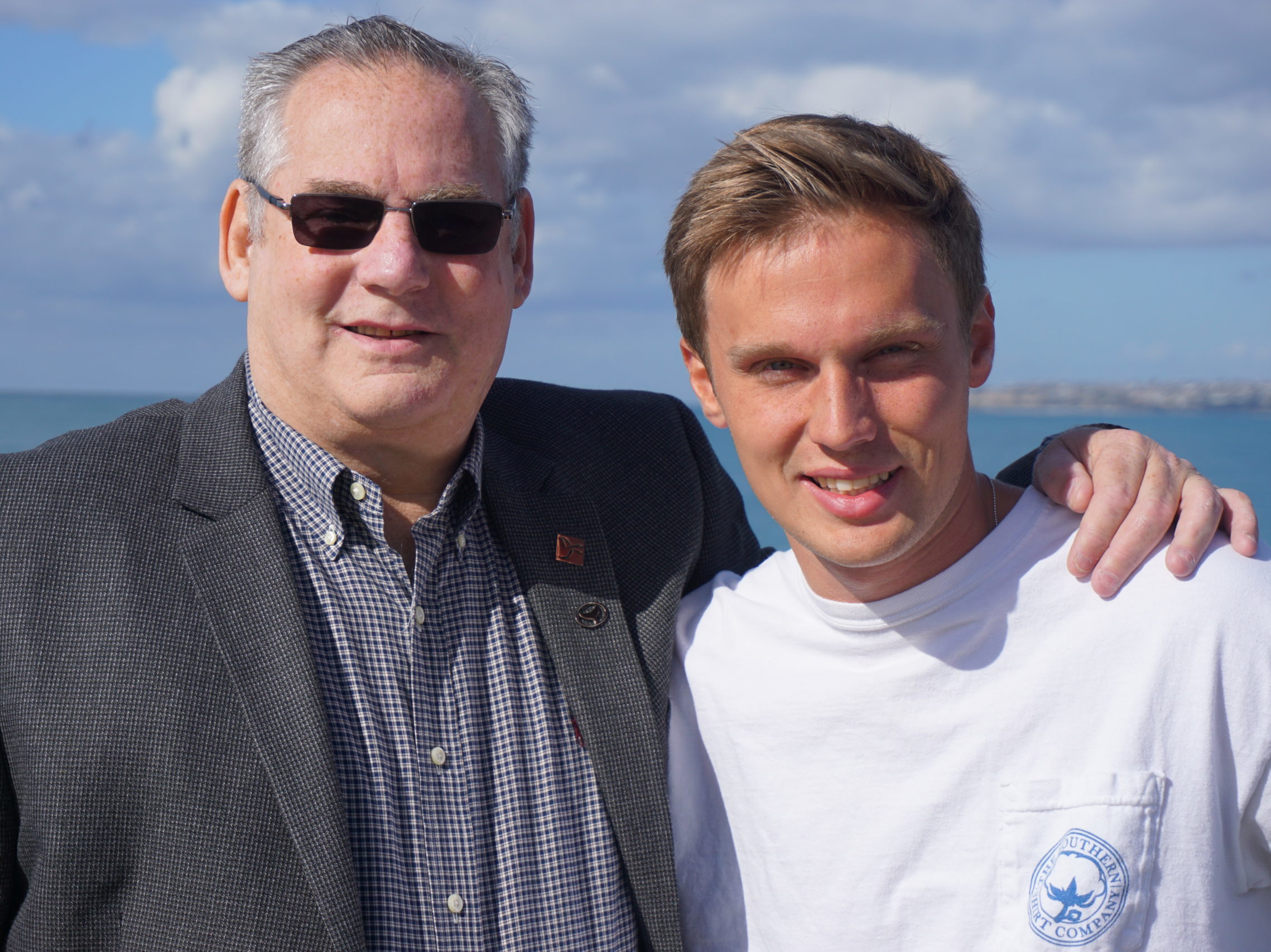
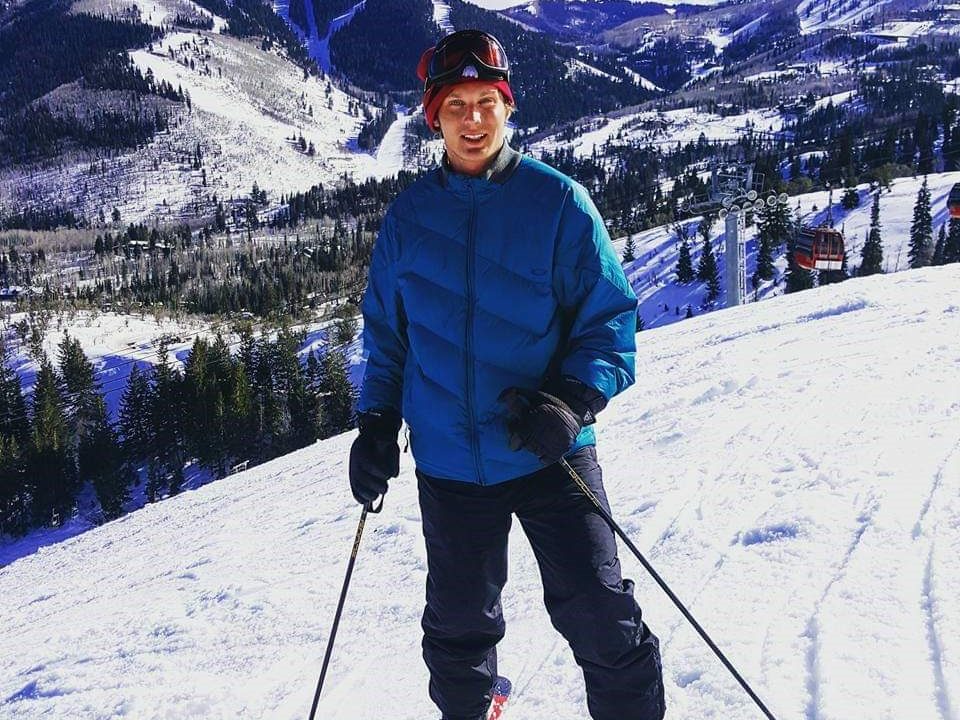
"The way I have dealt with this grief is to speak and try to help other kids and parents who have been affected by this disease."
I grew up in Troy, New York, which is about 10 miles north of Albany. My father was a dentist, and I had two sisters. As I was growing up, I was a skier and played pond hockey with my neighbors. I graduated from Kent State University. One day, as I was reading The Wall Street Journal (because business fascinated me), I saw an ad for an associate sales rep in Western Pennsylvania or Northeast Ohio. I had never been to Pittsburgh before, but I got the job and have stayed here ever since 1981. I met my wife Jane at college during my sophomore year when we lived in the same apartment complex, and we were married in 1984.
We waited a couple of years to have kids. Our first child was our daughter. I’ll never forget that night. It was a Tuesday night. I went down to the Penguin’s game with a friend. During the first intermission, I went and got something to eat. I did not hear my name announced over the loudspeaker. The second period started, and people came to my seats where I had season tickets and said, “Are you Rich Levitt?” I said, “Yes.” They said, “Your wife called. She’s having a baby. I think you’d better get home.” I went home. The doctor said it would be a couple of days. A couple of hours later, Lauren was born. That was February 7th in 1990.
Then a couple of years later, we wanted to have another child, and our son, Jonathan, was born on July 21th, 1994. Jonathan was into a little bit of everything, but even at a young age, Jonathan had a thirst for knowledge. He looked like Young Sheldon on TV. He had short hair and glasses. He had a briefcase because I had a briefcase. He was a great kid. He was into train sets. Jonathan was also very into being creative. His true love was Legos because he could build his own things. His imagination was always there. Then, he started to play sports. He tried baseball and soccer and started hockey at age eight. His first team was the Mites I believe at age nine. From there, he just had a passion for hockey and he developed into a tremendous athlete as well as a tremendous scholar.
Jonathan had a magnetic personality and was well liked by everyone. He always watched out for the underdog. During his senior year of high school, we noticed something wasn’t right. Although his grades slightly declined in his senior year, he had an excuse. This is one of the signs of opioid use that we did not see. What did we know? He was a leader in school activities, where he led his team to win the Penguins Cup for being the best hockey team in their division in western Pennsylvania. This feat never was achieved before or since at West Allegheny High School. We had him seen by many doctors and had him in therapy. We all know that when you have a substance use disorder, your brain changes: it gets hijacked. Even still, he graduated in 2012 with honors and was given a scholarship to college for his bachelor’s and his master’s degree.
He traveled the world: France, Italy, Israel, and Greece. He loved history and loved Italy the most. He also traveled in the U.S. from Hawaii to Boston and from California to Florida and the Bahamas. He was always reading a book. He averaged one a week and additionally read the web addition of the NY Times daily. He had a thirst for knowledge and education. When he was in France and everyone he was with went back to the Eiffel Tower, Jonathan went to the Louvre to see the Mona Lisa. From the Vietnam and Korean Wars to experiences in concentration camps, people shared their stories with him, and he loved listening to people’s stories, especially to elderly people. All of his interests started to change once his opioid use began to progress.
We believe Jonathan started his addiction at age 16. He had a virus. As good parents, we took him to a local Emergency Room. The doctor who examined Jonathan gave him a two-week supply of OxyContin. This started my son on a path that eventually led him to age 22, when he took a $4 bag of heroin that turned out to be 100% Fentanyl and died instantly in our basement.
There were times within the house when I had surgery and I noticed some pills were missing. In the back of my mind, I knew he was the one who took the missing pills. He did admit it was him after I called the pharmacy and checked. None of us were really worried about them being missing since we didn’t know what that all meant. Today I talk about this and share this education with people so people can be proactive. We just thought, “Okay, you took a couple of pills. That’s it. That’s the end of it.” “As close as we were to our kids, we did not have the knowledge of what the opioid crisis was.”
A lot of things had happened that were red flags, like his grades. There were stories that just didn’t seem real. There were times when he was working summer jobs and he said he wasn’t getting paid when really he was using the money for drugs. We found out after the fact because I said, “I know who owns the company you’re working for. I’m just going to call him and ask why you’re not getting paid.” When I started to call, he said, “Dad, hang up. I was getting paid.” There were other signs like asking for money and things going missing in the house. I had many items go missing, including pucks signed by Sidney Crosby and Mario Lemieux from coaching our kids together with Mario. My wife had jewelry go missing that was given down from her grandmother and mother. Jonathan had many excuses, but we didn’t know what these excuses meant. He was also losing weight because his appetite was different. There were times his sleeping habits were different. There were mood swings. His perception of things was off. There were times when he said he was going to a friend’s house, and so I went over to his friend’s house because I knew something wasn’t right, and he wasn’t there.
These were all signs of an individual that has a substance use disorder. However, we didn’t know. We were a great family. We did everything together. Every Saturday, we went to the grocery store together. Everybody would pick out what they liked. We had dinner together every night. We went on vacations together. We would clean up together. We would watch TV together. We would make sure our homework was done. As close as we were to our kids, we did not have the knowledge of what the opioid crisis was. We did not have the knowledge of what it would do to a family. We did not have the knowledge of the signs of what happens to our kids and the symptoms of substance use disorder.
We finally reacted to some of the things that didn’t make sense and made them a number one priority to discuss and talk about. At first, the situation was a little ugly because there was denial. Eventually, it was full disclosure, and that’s what we wanted. At that point, we realized how bad things were.
At college, Jonathan tried to be accepted with some upper-east-side kids in NYC. He would tell stories about how they always went to clubs. In the spring, Jonathan eventually flunked out of school. He came back to Pittsburgh and attended the Community College of Allegheny County. Jonathan eventually flunked out of this as well. We discovered that Jonathan went to school every day but instead of going to class, he got high in the parking lot. He would set his cell phone alarm to wake him in the afternoon around 3:00 PM to come home. When asked about school, he stated it was fine. We didn’t know about any of this until after he got his grades: all F’s. He finally confessed that he had a problem and needed help. He hated this disease and all the lying that he did everyday. He hated how his friends who knew about his drug use treated him. He went from being known for his magnetic personality to experiencing the stigma of a kid who had a substance use disorder.
That’s when we reached out and got help. We had him see a psychologist and participate in therapy, but when an individual goes to talk to someone and the parents aren’t there, the individual’s just going to say what the therapist wants to hear. The stigma of someone with an addiction faces is so powerful. They won’t tell the therapist, “I have an addiction.” That was never said. Jonathan would say, “Everything is perfect. Everything is great. Hockey’s great. Going back to school. Family is great.” We’d get, “He’s doing well.” It was just what Jonathan told the therapist. He was afraid of the stigma like many people, and this is what we have to overcome. I work with kids today and parents about overcoming stigma.Even on our street, when Jonathan went away for rehab, my wife and I thought, “Let’s just tell people that he went to New York to visit my sister and is going to school up there now. Let’s not tell everybody he’s going into rehab.” Then we thought, “We’ll just tell the closest friends,” but then we decided, “We’re just going to tell the truth.” As I always preach to my kids, tell the truth. Good or bad, the truth never changes.
We wanted to get Jonathan outside of Pittsburgh where there are no triggers that he knew. He knew where to get drugs here. He knew the dealers. His friends were using drugs. We wanted him outside Pittsburgh. We had no clue and no idea about where to get help, and little has changed today. We found the information by Googling it. We found a place on the Internet that looked great, a place in Michigan on the lake with beautiful cabins and a professional staff. Remember, everything on the Internet is not true.
The place he first went to was about 40 miles from the lake and was an old boarded-up nursing home now converted as a rehab facility with a part time staff. They let the patients come and go as they wanted. We talked several times a day, and he told us that some of the people he met were transferred to California. He became scared because this transfer always happened at night. He was smart enough to know that the picture in the front hall of Mr. Hubbard meant something. He called us and said, “Mom, Dad, I’m scared.” We could tell this was Jonathan speaking and not his addiction.
This was on a Sunday. We decided on Monday, the next day, we would go up and pick him up. However, we told Jonathan we’d be there Saturday, so nobody knew. I had just had back surgery, so I could not go. My wife, Jane, drove up there. We called the state police. The state police said, “Do not go in there alone. We will meet you.” The state police met Jane. They went in there. It took a little longer and the police threatened them, but Jonathan did come out with all his stuff in a big garbage bag and Jane and Jonathan came home.
He wanted to go back into rehab and spent all week researching rehab facilities. He wanted to get well. He sat on our back porch and called and called and called and searched and searched online. He found a place in San Clemente, California. They flew him out there, and it seemed pretty nice. Everybody had to do everything together in that place. If they went to the beach to play volleyball, everybody went to the beach to play volleyball. Then after that, he had to move into a halfway house in Laguna Beach for six months. That went very well. Someone did die of an overdose in the next house. Jonathan knew him and watched his body being taken out of the house with the coroner in a bag. It really, really upset him. He really wanted to get well. He was going to classes. He was still going to meetings, but then after six months, he needed to get out of the halfway house and get a job.
He moved into an apartment with a roommate right on U.S. Route 1 overlooking the ocean. I called in a favor from a friend and asked if he could interview Jonathan at this art gallery. They hired him on the spot. He worked for Wyland, Artist of the Sea, and he loved his job, and loved everyone he worked with. He loved art. There were many artists there, and he would always help the artists that would come in and do a special painting. Artists such as James Coleman, Walfrido, and others often gave Jonathan paintings as a thank you. He went out of his way to help; that’s the kind of person he was. He became a resident of California and was looking forward to going to UC at Irvine to get his college degree. We all thought life was good and getting better.
He relapsed in October of 2016. His roommate’s father took Jonathan to the hospital that evening, and he was put in detox. I went out to California the next day. His roommate was in detox in another hospital. I realized we had to get Jonathan back home. We brought him to a Cleveland Clinics rehab called Glenbeigh. It was a pretty nice facility. It was in the middle of Amish Country. There weren’t many triggers around there. He did well. Then after 30 days, they brought him to another city, Warren, Ohio. He wanted to come home, and I thought this was a good thing because family is important and he wanted to be with us on the holidays.
He returned home in December 2016. He was doing good, not great, but this takes time – a lot of time and love. He now was working at Robert Morris University in their hockey shop and was working at the rink where he learned to skate. He was making a little bit of money, and he would show us that; he was not hiding anything. He was planning to go back to the Community College of Allegheny County and then onto a four-year college. Jonathan went to hockey games with his sister. We were having family dinners every night. We were going grocery store shopping together again. We had open and honest communication.
It was February 9th. It was a Thursday. I remember these dates like it was yesterday. Jonathan came to me and said, “Dad, I’m working Friday, Saturday, and Sunday. I’m going back to school on Monday, so can I go out for a couple of hours.” I said to myself, “Okay, you’re doing well. Everything’s good. I can’t watch you 24 hours a day.” I had been trying to stay up every night because his sleep habits still weren’t very good. I let him go out and he called at about twenty to nine asking if I wanted some ice cream. He was actually thinking of the family, and I said yes.
He came home with the ice cream for all of us. The Pens played in Denver that night. It was a 9:00PM start. We sat, ate ice cream, and watched the Pens play. Then after eating ice cream, my wife and our daughter went to bed. It was just Jonathan and I, and I fell asleep about 9:30. I was exhausted from trying to stay up with him. I just couldn’t stay awake that night.
I woke up at 2:35AM in the morning, and the lights were on. I looked for Jonathan, and he wasn’t in his room. I went downstairs. I didn’t see him in the family room. The lights were on outside, but I keep the lights on all the time. In rehab, you typically take up smoking, and I didn’t like that, but he would smoke outside.
I looked in the backyard under the deck and I didn’t see him, but then coming back in the house, the basement door was open. The basement light was on. When Jonathan moved back to Pittsburgh, we set up a little man cave for him, so he could go down and watch his TV shows and play video games with his friends. It was his place to go.
I went down there and I found him. From the waist down he was on the couch. From the waist up, he’d just rolled over. The top of his head was on the floor. He wasn’t moving. Out of his mouth, there was bile and blood and mucus and other bodily fluids. We had about a six or seven foot pool of bile and bodily fluids that came out of his mouth and nose.
I ran upstairs. I got Lauren and my wife. I said, “Jane, come with me. Get the Narcan,” which we’d just bought the week before. I told Lauren to call 911. We had first responders here within three minutes. We had three officers, and a minute later we had an ambulance. His mother and I got him on the floor. We tilted his head back. We wiped his mouth. We did mouth to mouth breathing and chest compressions.
We did Narcan, and we did more chest compressions, but he was blue. His lips were purple. He was a little cold. The first responders worked on him for an hour. I sat on the bottom step and watched everything. My daughter and my wife sat up higher on the stairs, so they couldn’t actually see him. We tried for an hour and then we got him. We took him to the hospital. We followed the ambulance to the hospital.
When we got there, we asked, “We’re Jonathan Levitt’s parents. Where’s my son? How’s my son?” We were walking down this hall and it seemed to be like a mile long. It was about a quarter of four in the morning. I said to the nurse, “Just please tell me: is my son alive?” She said, “I’m so sorry.”
I passed out and fell. My wife fell on top of me. My daughter caught my wife. I was revived about five minutes later by the doctors and nurses. We walked down to the end of the hall. There was a door on the left, and we walked in, and there was Jonathan. His hair was all combed back. He had a white sheet up to his chest. His hands were at his side. Blue, cold, purple lips. He was dead.
He must have been dead for a while because Jonathan always helped others and he wanted to be an organ donor, but they could not use his organs. I just broke down and cried. That type of cry that hurts your stomach, uncontrollable, hysterical. I could not believe what I was looking at. This beautiful child, this gifted athlete, this brilliant academic person, who had his whole life in front of him, with a magnetic personality and a thirst for knowledge, and here he is lying motionless, dead.
That night Jonathan had met up with a friend that he met in rehab. They both texted each other on how they wanted to get better, but on this day the text was that they could get eight bags of heroin from the dealer. The trigger kicked in, the high-jacked brain was in motion, and they went and bought the eight bags. They each did two bags in the car. He then brought four bags home, and at least one of the bags he did at home was 100% fentanyl, and he died instantly.
February 10th was a tough morning. I’m not sure when we left the hospital, but we were all in shock. We were all crying. It was around 5:30 in the morning. We called relatives. I remember telling my sister, “Jonathan’s dead.” I think it was some of the hardest words I ever had to speak. Disbelief. My son, who I did so much with was gone. I remember in Laguna Beach when I visited him, every night was, “I love you, Dad,” and a big bear hug. With my bad back, I remember the times he would help me to the beach and get me set up on a chair, an umbrella, and a hat. He would have to go to work, but he would always come back and check on me, and now he was dead. These were sights I saw when I found him in the basement, when he was on the gurney, and while I was talking to my sister.
When we got home, we had about 20 people at our home. Everyone loved Jonathan. An hour later, my wife had a heart attack and was taken to Allegheny General Hospital by ambulance. It was that broken heart syndrome. I had my son dead in one hospital and my wife having a heart attack in another. Things were happening so fast. People were coming over. We would just break down and cry and fall in their arms. We had a service for family members on Monday. I cried hysterically because that’s the last time I saw my son at the funeral home. I know he’s with us in this room because I always see signs.
Two days later, we had a service at the church. It was supposed to be a very private and very small ceremony, about 50 people. There were 350 people there. People came in from 1,000 miles away, all people that Jonathan knew. My wife was out of the hospital, but she had to go some place calm and quiet to keep her heart healthy and cope with her grief, so she went to visit a friend for two weeks.
My daughter, wife, and I tried to put all this together. We all started seeing a counselor. I went to some grief sessions, but it was very hard for the first year for me. Even after six months, I would still think he’s in California. I still thought he’s going to walk through the door. It became more real as time went on that he wasn’t coming through that door.
I really didn’t know how to deal with my grief. About 10 months later, I started to do research. I started to learn. The way I have dealt with this grief is to speak and try to help other kids and parents who have been affected by this disease. I talk to kids in many schools, and I try to educate them on this opioid crisis and the signs of opioid use. I tell them Jonathan’s story and I relate it to all the facts. I tell the parents what to look for and how this can happen to anybody at any place and any time. Nobody is immune. I’ve found that the more I talk about it the more I get through the grief.
The one thing I can say is my son died in his house and he was taken care of. I have to be thankful for that. We don’t have to ask ourselves, “Where is he?” It does give me a little closure, but now I still have this grief to cope with. I’ve found the only way I can get through is talking to him every day. I know it’s okay to cry.
This is my passion now. Jonathan helped people. If it happened to me or his sister, Jonathan would be out helping people. My miracle as I walked down that hall in the hospital asking for my son to be alive didn’t happen. The miracle is that I am helping kids, and I have helped many kids. As I started speaking, I told my wife, “If I help one kid, it’s worth it.” I can now say I have helped dozens of kids.
When I go and talk at the schools, the kids pay attention. They’re mesmerized. They listen to me. I get responses back on Facebook from teachers and principles. It’s a powerful message. I’m not wearing a suit and tie. I go in sneakers and shorts, and I go as a parent with a broken heart. I tell them how my life used to be in balance and is not any more.
I encourage these kids to challenge themselves with education, sports, and out of school activities. Whatever obstacle they may have, these kids have to overcome it. They have to dig deep. We all have obstacles. Some of these kids have many obstacles. If you set your goals and keep working, you can do anything.
There’s one young lady that sent me a Facebook message. Her brother died of an overdose. Her mother and sister are heroin users. She sent me a message about how powerful my presentation was and how it had such a positive effect on her life. She said, “I also know now that it’s okay to cry every day.” She was living with an aunt, and she’s going to college this fall. She reached out to me on Facebook because I won’t give my business card to any kid, anybody under 18. If someone wants to contact me, they need to do it through the principal, the health teacher, or the superintendent. I’ve been contacted. I’m there for any questions, and I stay there as long as people need because I care about the kids. I truly care.
It’s important to me to continue this message because kids are at risk. Today, it’s not just heroin. There’s heroin, cocaine, methamphetamines, and many are mixed with fentanyl. Or you may get all fentanyl. My son died of 100% fentanyl that he thought was heroin. These kids have no idea what they’re buying. I don’t judge anybody. Instead, I encourage kids to pursue their goals: overcome obstacles, learn about acceptance, deal with peer pressure, get peer support, and work through issues.
I challenge the kids to step up and be a hero. If they see something like drug use going on, say something. If you’re all at a party and people are handing out pills, get out of there and call the police. Your friends may not like you, but when they realize you saved their life, they may think differently. We need to educate kids and parents. Kids need the communication with their parents, their teachers, their school, their church, their youth groups, and their friends. If you’re a parent or leader, talk to your kids about stigma because the chances are you will know someone who has gone through an overdose or an overdose death. People are in crisis mode. Instead of just running away, help them, love them, and support them. We need to overcome stigma. This is not an individual problem; it’s a community problem.
When Jonathan came down with this disease, I had no idea who to call, where to call, and where to get help. Today, there are many organizations that can help you. There’s the Substance Abuse and Mental Health Services Administration (SAMHSA) Hotline. SAMHSA will provide you with local resources to get help. There are also county drug and alcohol numbers. There are federal drug and alcohol numbers. There are local organizations. Even your police department will help you. We want to make sure everyone gets into recovery and gets the help they need.
This is why I am sharing my story. The last two years have been extremely difficult. I now speak and educate people on the opioid crisis. I have been to Pittsburgh public schools and many schools in the southwest part of Pennsylvania, Rotary clubs, youth groups, and many other organizations. I will travel anyplace to help save a life. Every life matters. I work very closely with the local and state law enforcement, DEA, FBI, city, county, and Attorney General’s office. We have to overcome this disease of addiction and overcome stigma and get people help.
For more information:
WTAE Interview: https://www.wtae.com/article/i-want-to-carry-on-my-sons-legacy-pittsburgh-area-father-has-message-after-sons-overdose-death/27304181
Link to Jonathan’s Story & The Opioid Crisis: https://vimeo.com/channels/1192788
Link to Friends of Safe Schools PA Article: https://www.friendsofsafeschoolspa.org/jonathan-s-story
Link to Community Health Magazine Article: http://www.communityhealthmagazine.com/inspiration/while-a-complex-opioid-crisis-sweeps-the-nation-a-family/article_75f26ad6-bc3c-11e8-acc4-071478e77c8e.html?fbclid=IwAR10A6PRO8s5DzRGal_kRBdDOiQ_9F8cSsGgpAJ2PKzETUHK9tY4lgIg_KM
Contact:
Richard Levitt
4512 Beaver Run Circle
Imperial, Pa. 15126
Cell: 412-770-4766
E-mail: [email protected]
